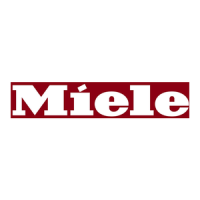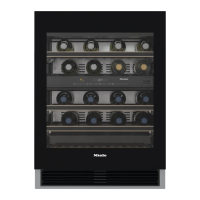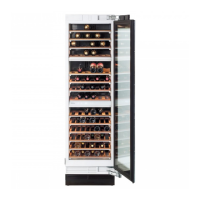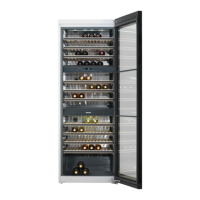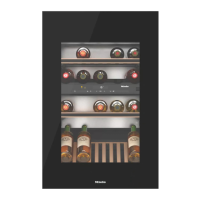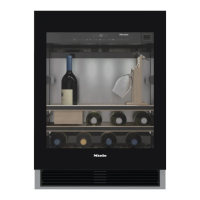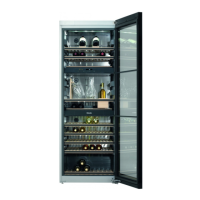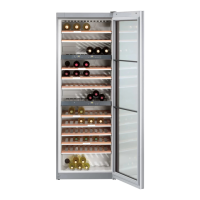Do you have a question about the Miele KWT6832SGS and is the answer not in the manual?
Basic safety measures and warnings for appliance use and installation.
Risk of glass door breaking at altitudes above 4900 ft due to air pressure.
Intended use for domestic environments and wine storage only; not for outdoor or explosive areas.
Guidelines for supervising children around and using the appliance.
Safe disposal of packaging materials to prevent suffocation hazards for children.
Information on refrigerant, room space requirements, and electrical grounding.
Ensuring proper grounding and avoiding extension cords for electrical safety.
Avoid moist areas and non-stationary locations; check for visible damage.
Adhering to climate range, not blocking vents, handling greasy foods, and storing flammables.
Use of qualified personnel and original parts for safety and warranty.
Use only original Miele parts to maintain warranty and safety.
Avoid oil/grease on seals, steam cleaners, sharp objects, and electric heaters for cleaning.
Make door latches unusable to prevent child entrapment; handle cooling system with care.
Identifies buttons and sensors for operating the appliance and its functions.
Explanation of symbols used in the appliance's settings menu.
Diagram labeling internal and external parts of the wine storage unit.
Details on active charcoal filter, stainless steel maintenance cloth, and chalk.
Information on availability of additional optional accessories from Miele.
Guidance on installation, maintenance, temperature setting, and usage for reduced energy consumption.
Instructions for removing protective film and initial cleaning.
How to turn the appliance on, initial display indications, and interior lighting.
How to set temperatures and activate DynaCool for individual wine storage zones.
Procedure for turning the appliance off, including safety lock activation.
How to turn the appliance off in Sabbath mode.
Steps for turning off and preparing the appliance for extended periods of non-use.
How to activate/deactivate the safety lock to prevent accidental changes to settings.
Customizing button tones and door alarm behavior.
Adjusting the brightness level of the appliance's display.
Enabling Sabbath mode for religious observance, disabling certain functions.
Procedure to exit Sabbath mode and restore normal operation.
How temperature and air quality affect wine maturation and storage.
Table of recommended temperatures for various wine types.
How the appliance maintains temperature during low ambient conditions.
Explanation of how isolator panels create separate temperature zones.
Step-by-step guide to adjusting temperatures for each zone.
Range of adjustable temperatures for the wine storage zones.
How the actual temperature is shown on the display.
Importance of humidity for wine storage and avoiding moisture introduction.
How DynaCool maintains relative humidity and distributes temperature evenly.
Instructions for activating and deactivating the DynaCool function.
Role of the active charcoal filter in maintaining air quality and freshness.
How temperature deviations trigger audio and visual alarms.
How to silence the audible alarm temporarily.
Appliance features to protect wine from sharp temperature drops.
Alarm triggered by the door being left open for more than 2 minutes.
How to silence the door alarm before closing the door.
Setting interior lighting to stay on for wine display when the door is closed.
How to adjust the brightness level of the interior lighting.
Adjusting how long the interior lighting remains on after the door is opened.
Description of wooden shelves, their runners, and capacity notes.
Instructions for removing and re-inserting wooden shelves.
How to adjust individual slats for secure bottle storage.
Using chalk and magnetic strips for wine identification.
Using the display rack for prominent bottle presentation.
Information on the total number of bottles and shelf load capacity.
Placing covers on runners for a finished look.
Using the glass holder for storing and chilling wine glasses.
Storing opened wine bottles using the bottle holder and dividers.
Using the accessory box for storing items like corkscrews and chalk.
Creating decanting shelves for wine maturation and turbidity settling.
Placement of the decorative shelf at the bottom of the appliance.
Information on receiving additional bottle presenters with the sommelier set.
How condensate and frost are automatically removed and drained.
General warnings and items to avoid during cleaning and maintenance.
Steps to take before cleaning, including unplugging and removing items.
Instructions for cleaning the appliance's exterior, interior, and accessories.
Using Miele's specific cleaner for stainless steel surfaces.
Importance of cleaning ventilation slits for energy efficiency.
Proper cleaning of the door seal to prevent deterioration.
Dusting the compressor and metal grill annually for optimal performance.
Ensuring fresh, odor-free air supply and filter replacement.
Step-by-step guide for replacing the active charcoal filter.
Procedure to confirm filter replacement and reset the indicator.
Solutions for issues where interior lighting and temperature display are not working.
Causes and solutions for the compressor running often and temperatures dropping.
Interpreting alarm symbols, filter change indicator, dashes, and error codes.
Solutions for interior lighting not working or staying on when the door is closed.
Resolving issues with no acoustic alarm, inability to turn off, and shelf warping.
Descriptions of normal operating noises and their sources.
Solutions for rattling or clinking sounds caused by leveling or placement.
Information on contacting Miele dealer or Technical Service for faults.
Details about Miele's extended service contract for appliance coverage.
How to turn the appliance on and off in Demo mode.
Procedure to exit Demo mode and return the appliance to normal operation.
Information regarding product specification, technical, and warranty details.
Environmentally friendly disposal of packaging and keeping it away from children.
Recycling old appliances and protecting the environment during disposal.
Hazards related to improper grounding, unauthorized repairs, and voltage verification.
Ensuring proper grounding and avoiding modifications to the plug.
Requirements for connection voltage, frequency, amperage, and plug type.
Ensuring accessible outlets, cable integrity, and avoiding extension cords.
Restrictions on using standalone inverters and energy-saving devices.
Guidelines for choosing a suitable location, avoiding sunlight and heat sources.
Matching appliance climate class to ambient room temperature.
Ensuring adequate ventilation by not covering slits and keeping them clean.
Ensuring the installation floor is flat, level, and can bear the appliance's weight.
Using front feet and a wrench to align the appliance.
Adjusting the door hinge plate foot for proper door leveling.
Information on the door opening angle limiter and its availability.
Diagram showing the overall dimensions of the appliance.
Diagram showing space required when the appliance door is opened.
List of tools required for changing the door hinging.
Step-by-step instructions for safely removing the appliance door.
Instructions for detaching and reattaching the soft-close mechanism.
Steps for removing, rotating, and re-inserting the hinge bracket.
Removing top covers and bearing bolts for door removal.
Procedure for removing, rotating, and re-securing hinge brackets and covers.
Attaching the bottom hinge bracket, adjustable foot, and covers.
Steps for placing the door back onto the bottom bolt and securing it.
Reattaching the soft-close mechanism and securing the bolt.
Adjusting door alignment using the upper hinge bracket.
Loosening screws, moving hinge bracket, and checking door alignment.
Basic safety measures and warnings for appliance use and installation.
Risk of glass door breaking at altitudes above 4900 ft due to air pressure.
Intended use for domestic environments and wine storage only; not for outdoor or explosive areas.
Guidelines for supervising children around and using the appliance.
Safe disposal of packaging materials to prevent suffocation hazards for children.
Information on refrigerant, room space requirements, and electrical grounding.
Ensuring proper grounding and avoiding extension cords for electrical safety.
Avoid moist areas and non-stationary locations; check for visible damage.
Adhering to climate range, not blocking vents, handling greasy foods, and storing flammables.
Use of qualified personnel and original parts for safety and warranty.
Use only original Miele parts to maintain warranty and safety.
Avoid oil/grease on seals, steam cleaners, sharp objects, and electric heaters for cleaning.
Make door latches unusable to prevent child entrapment; handle cooling system with care.
Identifies buttons and sensors for operating the appliance and its functions.
Explanation of symbols used in the appliance's settings menu.
Diagram labeling internal and external parts of the wine storage unit.
Details on active charcoal filter, stainless steel maintenance cloth, and chalk.
Information on availability of additional optional accessories from Miele.
Guidance on installation, maintenance, temperature setting, and usage for reduced energy consumption.
Instructions for removing protective film and initial cleaning.
How to turn the appliance on, initial display indications, and interior lighting.
How to set temperatures and activate DynaCool for individual wine storage zones.
Procedure for turning the appliance off, including safety lock activation.
How to turn the appliance off in Sabbath mode.
Steps for turning off and preparing the appliance for extended periods of non-use.
How to activate/deactivate the safety lock to prevent accidental changes to settings.
Customizing button tones and door alarm behavior.
Adjusting the brightness level of the appliance's display.
Enabling Sabbath mode for religious observance, disabling certain functions.
Procedure to exit Sabbath mode and restore normal operation.
How temperature and air quality affect wine maturation and storage.
Table of recommended temperatures for various wine types.
How the appliance maintains temperature during low ambient conditions.
Explanation of how isolator panels create separate temperature zones.
Step-by-step guide to adjusting temperatures for each zone.
Range of adjustable temperatures for the wine storage zones.
How the actual temperature is shown on the display.
Importance of humidity for wine storage and avoiding moisture introduction.
How DynaCool maintains relative humidity and distributes temperature evenly.
Instructions for activating and deactivating the DynaCool function.
Role of the active charcoal filter in maintaining air quality and freshness.
How temperature deviations trigger audio and visual alarms.
How to silence the audible alarm temporarily.
Appliance features to protect wine from sharp temperature drops.
Alarm triggered by the door being left open for more than 2 minutes.
How to silence the door alarm before closing the door.
Setting interior lighting to stay on for wine display when the door is closed.
How to adjust the brightness level of the interior lighting.
Adjusting how long the interior lighting remains on after the door is opened.
Description of wooden shelves, their runners, and capacity notes.
Instructions for removing and re-inserting wooden shelves.
How to adjust individual slats for secure bottle storage.
Using chalk and magnetic strips for wine identification.
Using the display rack for prominent bottle presentation.
Information on the total number of bottles and shelf load capacity.
Placing covers on runners for a finished look.
Using the glass holder for storing and chilling wine glasses.
Storing opened wine bottles using the bottle holder and dividers.
Using the accessory box for storing items like corkscrews and chalk.
Creating decanting shelves for wine maturation and turbidity settling.
Placement of the decorative shelf at the bottom of the appliance.
Information on receiving additional bottle presenters with the sommelier set.
How condensate and frost are automatically removed and drained.
General warnings and items to avoid during cleaning and maintenance.
Steps to take before cleaning, including unplugging and removing items.
Instructions for cleaning the appliance's exterior, interior, and accessories.
Using Miele's specific cleaner for stainless steel surfaces.
Importance of cleaning ventilation slits for energy efficiency.
Proper cleaning of the door seal to prevent deterioration.
Dusting the compressor and metal grill annually for optimal performance.
Ensuring fresh, odor-free air supply and filter replacement.
Step-by-step guide for replacing the active charcoal filter.
Procedure to confirm filter replacement and reset the indicator.
Solutions for issues where interior lighting and temperature display are not working.
Causes and solutions for the compressor running often and temperatures dropping.
Interpreting alarm symbols, filter change indicator, dashes, and error codes.
Solutions for interior lighting not working or staying on when the door is closed.
Resolving issues with no acoustic alarm, inability to turn off, and shelf warping.
Descriptions of normal operating noises and their sources.
Solutions for rattling or clinking sounds caused by leveling or placement.
Information on contacting Miele dealer or Technical Service for faults.
Details about Miele's extended service contract for appliance coverage.
How to turn the appliance on and off in Demo mode.
Procedure to exit Demo mode and return the appliance to normal operation.
Information regarding product specification, technical, and warranty details.
Environmentally friendly disposal of packaging and keeping it away from children.
Recycling old appliances and protecting the environment during disposal.
Hazards related to improper grounding, unauthorized repairs, and voltage verification.
Ensuring proper grounding and avoiding modifications to the plug.
Requirements for connection voltage, frequency, amperage, and plug type.
Ensuring accessible outlets, cable integrity, and avoiding extension cords.
Restrictions on using standalone inverters and energy-saving devices.
Guidelines for choosing a suitable location, avoiding sunlight and heat sources.
Matching appliance climate class to ambient room temperature.
Ensuring adequate ventilation by not covering slits and keeping them clean.
Ensuring the installation floor is flat, level, and can bear the appliance's weight.
Using front feet and a wrench to align the appliance.
Adjusting the door hinge plate foot for proper door leveling.
Information on the door opening angle limiter and its availability.
Diagram showing the overall dimensions of the appliance.
Diagram showing space required when the appliance door is opened.
List of tools required for changing the door hinging.
Step-by-step instructions for safely removing the appliance door.
Instructions for detaching and reattaching the soft-close mechanism.
Steps for removing, rotating, and re-inserting the hinge bracket.
Removing top covers and bearing bolts for door removal.
Procedure for removing, rotating, and re-securing hinge brackets and covers.
Attaching the bottom hinge bracket, adjustable foot, and covers.
Steps for placing the door back onto the bottom bolt and securing it.
Reattaching the soft-close mechanism and securing the bolt.
Adjusting door alignment using the upper hinge bracket.
Loosening screws, moving hinge bracket, and checking door alignment.
| Brand | Miele |
|---|---|
| Model | KWT6832SGS |
| Category | Wine Cooler |
| Language | English |
